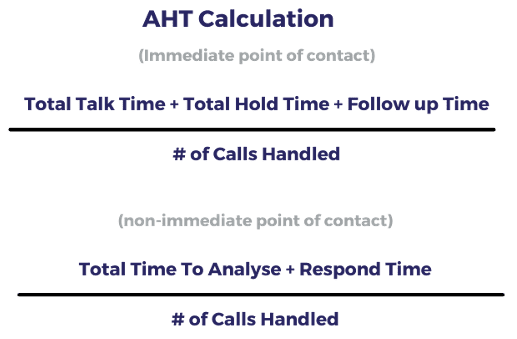Contact Centres are dynamic and high energy environments, requiring a contact centre leader to have clear KPIs to provide visibility on the performance of your team.
The challenge for establishing KPIs for your contact centre is understanding what action you will take based on the goals you are tracking. To help you develop the right KPIs for your contact centre, here are some of the most popular metrics used and why they are important.
1) Average Handle Time (AHT)
Average Handle Time (AHT) is the average duration of the call, starting from the time the customer initiates the call, to call completion, including hold times and transfers.
One key trait of a high performing contact centre is the ability of agents to serve customers quickly and accurately. The calculation of Average Handle Time is the ‘Total talk time’ + ‘Total Hold Time’ + ‘Follow up Time’ which is then divided by the total number of tickets handled.
Ways to improve this metric include:
- Leveraging agent scripts which contain custom fields such as what and when the item was purchased so your agents are armed with the information they need to serve customers faster.
- Integrating your contact centre technology with your CRM using a CTI (Call Telephony Integration). ipSCAPE has CTI adaptors for Salesforce, ServiceNow, Zendesk and Microsoft Dynamics 365

2) First Call Resolution
First Call Resolution (FCR) is a commonly tracked metric by contact centre managers. It measures a contact centres ability to resolve a customer query, question, or problem in the first call or interaction. FCR is measured by the ‘Total number of calls resolved on the First Call’ divided by the ‘Total number of calls received’. You can complete this through Internal or external methods.
- Internal: agent logging, quality monitoring, re-opened tickets and repeats call tracking
- External: post-call phone surveys and email surveys to customers
So how can you improve First Call Resolution in your contact centre?
Routing calls to a person who possesses the knowledge and expertise to help serve the customer. This can be achieved through implementing an intelligent IVR which can combine customer data into your routing logic such as understand identifying a customer by their phone number to allocate them to the right department.

First Call Resolution is a metric that intrinsically linked to customer satisfaction and loyalty and can also be an indicator of cost reduction opportunities. Industry benchmarks for First Call resolution are around 75-80%, but this can be relative to what type of call centre you manage. ipSCAPE has a team of contact centre industry experts who can help you understand what metrics are right for your organisation.
3) Abandonment Rate
If you are a revenue generating call centre, this metric is critical for your organisation. Every call abandoned equates to revenue and is directly correlated to customer wait times. The Abandonment rate is the percentage of inbound calls that are abandoned by the customer before speaking with an agent.
Factors that impact Abandonment rates include:
- Staffing levels
- Message automation
- Call routing
Therefore, if you recognise a high abandonment rate, you should act quickly to ensure the right options are implemented.

Ensuring your contact centre is adequately staffed can be achieved with workforce management technology or integration of your contact centre data with Business Intelligence tools such as Power BI.
ipSCAPE’s cloud contact centre technology also has built-in live reports and wallboards that can help you gain real-time insights on the performance of your contact centre. ipSCAPE also integrates with leading Business Intelligence tools including Power BI, Holistics, Sisense and Tableau.
These tools can provide reports showing trends in customer calls and help guide decision making on rostering for peak seasons and times of day.
Technology such as utilising call-back options in the IVR such as ‘Maintain Position in Queue’ gives customers the option to request a call back from an agent but still maintain their position in the queue after they have hung up the phone.
Similarly, an intelligent IVR that uses Virtual Agents can also serve automated messages to customers. ipSCAPE helps a utilities organisation serve over 20,000 customers a day during peak periods using our intelligent IVR technology that communicates service outage notifications based on a caller’s postcode.
4) Customer Satisfaction (CSAT)
A 2019 Forrester report found that companies that prioritise customer experience outperform other businesses by nearly 80% (Forrester, 2019). Therefore, many Customer Experience leaders are actively trying to measure and improve the customer experience.
Customer satisfaction or CSAT is a metric that is used to better understand how satisfied your customers are with a product, service, or a particular interaction. CSAT can be used by your business to improve customer loyalty by providing the right data to capitalise on your strengths and taking proactive measures to address your weaknesses.

CSAT can be measured through a post-call survey in your IVR workflow. After a call, a customer will be asked to provide a rating out of 5 based on “How would you rate your overall satisfaction with your experience calling (organisation) today?”
5) Net Promoter Score (NPS)
Net Promoter Score (NPS) is a growth indicator as it can discern how satisfied customers are, how brand loyal they are and how likely your customers are to recommend your business to others.
NPS is usually measured using a question that asks how likely a customer is to recommend the business to their family or friends. This metric is usually rated out 10 or 100.
To understand what constitutes a good NPS score, contact centre leaders must initially understand the segmentation of the different scores. Your customers can fall into one of three segments:
- Detractors – are customers that are generally unhappy with your brand, product, or service. They would give a rating of 0-6 or 0-60.
- Passives – are customers who have a neutral standpoint on your brand, product, or service. They would give a rating of 7-8 or 70-80. Contact centre leaders should be wary of passives as they can easily become a detractor.
- Promoters – are customers that are advocates for your brand, product, and services. They would give your business a 9-10, or 90-100.

NPS is an indicator. It allows you to monitor improvements in your organisation, its products and services over an extended period. Business leaders should collect more data to analyse alongside your NPS and CSAT scores to better understand what is driving your customer experience. This will allow you to prioritise organisational improvements that will have the biggest impact on your customers. Post-call surveys are a valuable tool that can be used to collect both NPS and CSAT data.
Does your Contact Centre Technology provide you with the tools you need to track and measure these KPIs? ipSCAPE have decades of contact centre industry experience and we can help you create a high performing contact centre today. Contact us today to find out more.
